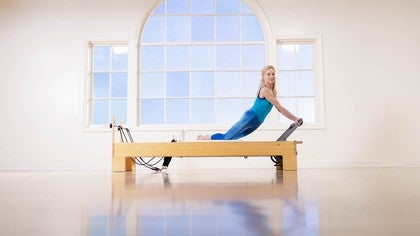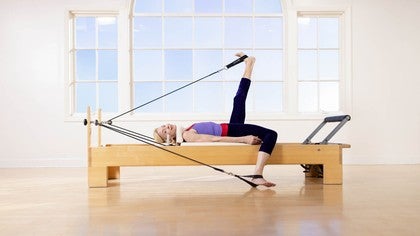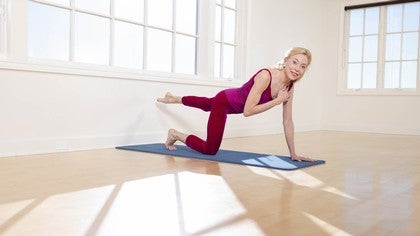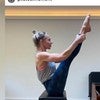Description
About This Video
Transcript
Read Full Transcript
Welcome to Oscillation Rejuvenation. Place your mat perpendicular to the wall, and reach for a head cushion or pillow in case you would like to have support for your head, your neck, or cushion for your knees. Come to lie on your front with your bent elbow, palms on the wall. Place your palms a comfortable distance up the wall and wide as your shoulders, or even wider. Tuck your toes under, and press your heels back away from the wall.
Now you start a ground force conversation between the soles of your toes tucked under on the floor, on the mat, and your palms against the wall. The ground force conversation is shared through the front of your ribs, the front of your pelvis, the front of your thighs. Breathing in lightly through your nose, breathing in, and exhale humming, exhaling through your nose, humming any register you choose. Once again breathing in, expanding laterally and posteriorly through the volume of your thorax, humming. (Elizabeth humming) Press more strongly with your right hand, turning your head, neck, and eyes towards the left.
So your right ear is hovered above the ground and listening to the ground. Pressing more strongly with your left hand, turn your head, neck and eyes to the right, breathing in, and exhale humming. (Elizabeth humming) Bending your left elbow, plant your left palm on the ground. The ground next to your left shoulder or your left ribs. Breathing in, expanding laterally and posteriorly, and humming.
(Elizabeth humming) Turn your head, neck, and eyes to the left. Always redistributing your ground forces, your right palm to your left toes, and exhale humming. (Elizabeth humming) Pressing more strongly with your left hand, turn your head, neck, and eyes to the right, looking above, beyond your right elbow, and exhale humming. (Elizabeth humming) Change hands, your left palm is on the wall. Your right palm is on the ground, a comfortable distance alongside your right ribs, your right shoulder, pressing more strongly with your left hand turning towards the right, breathing in.
As you're comfortable, always breathing in and out through your nose lightly and easily. Continue your rocking rhythm. As you rotate, turn your head, neck, and eyes left, looking towards and beyond your left elbow. Exhale, come to the center. Bending both elbows, palms are alongside your ribs or alongside your shoulders.
Breathing in, hovering your chest bone even higher up the mat, aiming your gaze where the floor and the wall meet. So now you're in more thoracic and cervical extension. Sustain this as you hover your left foot off the ground. So left plantar flexion accompanies left hip extension. Breathing in, and exhale humming.
(Elizabeth humming) Change legs now, keep your oscillating rhythm. Hover your next foot off the mat, hip extension and ankle plantar flexion, breathing in, and exhale humming. (Elizabeth humming) Tuck all toes under, reduce the amount of thoracic extension, your forehead and nose, they're hovered above the ground. Change your arm position so your arms are alongside you, palms up, hands hover off the ground. Breathing in, lifting your chest bone, lifting your gaze.
And exhale humming. (Elizabeth humming) Turn your head, neck, and eyes to the left, hover your left foot off the ground, left leg and hip extension, pressing your palms towards the ceiling. And exhale humming as you come back through the middle, through the midline. Tuck your left toes under, hover your right leg up off the ground and hip extension, turning your head, neck, and eyes to the right as your palms come closer to the ceiling. Exhale humming.
(Elizabeth humming) Tuck all toes under, reach both arms wide to the side, palms above the ground. Breathing in, and exhale humming. (Elizabeth humming) Bring your arms alongside you, cease the rocking, settle your knees, the tops of your feet into the ground. Turn your head, neck, and eyes to one side, sink into your mat, listening to the echoes, the vibrations, the resonance, of your oscillation. If it is appealing to you, you could imagine sinking into your mat of warm sand.
Turn your head to the new side now, and if you're wearing a mic headset, then don't put your head down. But otherwise, you put your head down and I will just live vicariously through you. Now, if you're not happy about warm sand, then you might enjoy cool something else. So you choose the temperature, and the image that's most soothing for you. Change your orientation now to lie on your side.
So you come to lie on your side. Initially you'll have your knees bent, your knees one on top the other, and your knees forward of your hip joints. Your bent elbow palms are on the wall, sink your ribs, your waist down into the floor. This might be the moment for your head cushion or pillow to make you more comfortable on your side. Now, scissor your legs so that the ceiling leg is back and the floor leg is forward.
You can have your knees bent or your legs outstretched as it suits you. Begin the rocking conversation, the oscillation, generating the force through the palms of your hands on the wall. And then there will be some contact with the little toe side of your front foot and the big toe side of your back foot. No surprise to you, there's a fair amount of ground force also through your greater trochanter to the side of your pelvis in contact with the ground, and the side of your shoulder. As you inhale, sink into the ground.
And as you exhale, lift up your ribs and lift up your waist. Breathing in, laterally translating and side bending towards the ground, pushing more strongly with your top hand. And then lift up your ribs and lift up your waist, pushing more strongly with your bottom arm. Once again, breathing in, and exhale humming. (Elizabeth humming) Pressing more strongly with your ceiling hand, turn your head, neck, and eyes towards the ground, and use the humming exhalation to bring you back towards the midline.
Pressing more strongly with your floor palm, turn your head, neck, and eyes upwards towards the ceiling, heavenward, and exhale humming. (Elizabeth humming) Keep the rocking rhythm going with your palms, your arms, and organize your legs, aligned with your sitting bones. Bending your top knee, plant the sole of your foot on the ground, the sole of your floor, little toe is tucked under. Your floor hand is forward, and your ceiling palm interlaced with your fingers. Rock on now, and the responsibility for generating this oscillation is coming from the ground force of your foot on the floor, your little toe side of your foot on the floor, breathing in, lifting up your ribs and lifting up your waist, and exhale humming.
(Elizabeth humming) I switch the breath rhythms on you, you have to watch me, I do that often. Creating a ground force with the side of your shoulder and the side of your arm, lifting up your ribs and lifting up your waist, inhale to the ceiling, and as you exhale, sink your ribs, your waist into the ground. As you lift up your ribs and waist, turn your head, neck, and eyes to see the floor. And exhale, sink your ribs and waist into the ground, pressing your floor palm up to the ceiling. Then turn your head, neck, and eyes towards the ceiling.
Lifting up your ribs, lifting up your waist, always keeping the rhythm going as you appreciate the new ground force orientations, Come back to the center, easy now, let this go, and roll to lie on your back. While you're here, you have kinesthetic listening, appreciating the echoes of the oscillation, appreciating the vibrations, the resonances that are coursing through your whole structure and your whole field. It's not unusual, after one session of rocking on your side, oscillating on your side, to be swept away by kinesthetic hallucinations or somatic hallucinations. Feeling like, "Oh, one side moves so easily when I breathe, and the other side not so much." That was an example of shamelessly leading the witness, so if you didn't feel that, no problem. We're just moving onto the new side.
Here you are on your new side. Your bent elbow palms are on the wall. You start with your knees forward of your hip joints, and then scissor your legs, so the floor leg is forward and the ceiling leg is back. You can either keep your knees bent or extend your knees so that the big toe side of your back foot, and the little toe side of your front foot, they have some shared responsibility for creating the ground force that's initiated by your palms on the wall. Sinking your ribs, your waist into the ground, inhalation as if you could inhale through the ground lung to fill up to your ribs.
And exhale, increase the pressure of your palms on the wall, lift up your ribs and lift up your waist. Breathing in, it's a lateral translation and side bending of your thorax, of your rib basket. And exhale humming. (Elizabeth humming) Pressing more strongly with your ceiling palm. Turn your head, neck, and eyes to see the ground, and exhale humming.
(Elizabeth humming) Pressing more strongly with your floor hand, breathing in as your ribs sink to the ground, turn your head, neck, and eyes upward. And exhale, lift up your ribs and lift up your waist. Rock on here, bring your floor palm forward, and then bring your ceiling palm in contact with your floor palm, so both hands are outstretched in front of your low ribs. This is more demanding in terms of keeping the oscillation rhythm going because it's only the contact that your feet have with the ground, shared with the side of your pelvis, and shared with the side of your ribs. Bring your legs aligned with your torso, and now, it's your arms in contact with the ground.
Bend your ceiling knee, plant your foot on the floor. Rock on here, pressing your floor palm up to your ceiling palm, turn your head, neck, and eyes to see the ground, breathing in, and exhale humming. (Elizabeth humming) Turn your head, neck, and eyes to see the ceiling, things are looking up, especially when you have the ground force of your ribs pressed into the floor, and exhale, lift up your ribs and lift up your waist as you come forward. Leave this now, cease the rocking, and come to lie on your mat. As you sink into the mat, marvel at just the spontaneous movements that come to you here, particularly in the area of your ribs, area of your thorax.
Staying on your back, on your mat, bending your elbows so that your palms are on the wall. A comfortable distance, a comfortable distance, wider, either wider or even with your shoulders, and higher or lower to the ground, as you prefer, for your wrists, your elbows, and your shoulders. Bend both knees, plant the soles of your feet in contact with the ground, probably heels are a pelvis width apart, greater trochanter width apart. Now thus far, you've attended to the expansion of the different ground forces to facilitate movement of your thorax. When you were relying on your front, the expansion was primarily laterally and posteriorly.
When you were lying on your side, you had a movement conversation between the two sides of your thorax. Now here you are lying on your back, and because of the ground forces pressing into the back of your ribs, it will facilitate motion through the side and through the front. Sharing the movement conversation between the palms of your hands on the wall suctioned onto the wall, and the soles of your feet suctioned onto the ground, onto your mat. Now this oscillation, this rocking conversation between your palms and the soles of your feet, this conversation includes the back of your sacrum, so that's the back of the volume of your pelvis, the back of your thorax, between your shoulder blades, the volume of your rib basket, the back of your head. Rock on here, as you exhale, nod your nose downward, sliding your gaze behind the cheekbones of your face.
Roll your head, neck, and shoulders up. This unsupported cervical flexion will load the deep neck flexors, the deep cervical flexors, and will load also the deep front myofascial continuity. While you're up, press more strongly with your left hand, turn your head, neck, and eyes to the right. So it's cervical flexion with rotation. Come back to the middle, attending to the ground force to your right palm, turn, rotate your head, neck and eyes left, and exhale humming.
(Elizabeth humming) Rather than overstaying your welcome, put your head down on the ground, resume the rocking rhythm, and now pick up your right foot and cross your right shin over your left thigh. Breathing in, and exhale humming. (Elizabeth humming) Keep your rocking rhythm going, plant the sole of your right foot, cross your left shin over your right ankle, over your right thigh, my mistake, so that your left ankle is in dorsiflexion, and rock on as you put your foot down. Now slide your right foot away from your torso, and now you have a renewed lease on life because you are involved in heel rocking, the back of your heels in, the back of your heel in contact with the ground pressing more strongly with your left hand, turn your head, neck, and eyes to the right, appreciating the subtle yet palpable rearrangements of your whole neuromyofascial system. Come back to the middle, bending your right knee, put your right foot down, slide your left leg out long, pressing more strongly with your right hand, there's the ground force coming from the back of your left heel, in plantar dorsiflexion, turn your head, neck, and eyes to the right.
Left ear is listening to the ground. Exhale, come back to the middle. Slide both feet out long on the ground so your right heel joins your left heel, Heels are greater trochanter width apart. There's an internal rotation spiral through your legs coming from your hip joints. Big toes towards the midline.
Take your hands off the wall and place your right palm on the ground next to your ear, and place your left palm on the ground next to your ear. I jumped the gun a little bit, not quite right. Plant your left palm over your right elbow, so now you have the ground force distribution from the back of your heels through your sacrum. So you have the volume of your pelvis, the volume of your thorax, and your right palm on the ground and your left hand on your right elbow. Keep the rocking rhythm going, and change to your new side.
Your right palm is over your left elbow, rock on here. Now, you can have both palms on the ground, and it's the backs of your heels that have the primary responsibility of rocking you, breathing in, and exhale humming. (Elizabeth humming) Palms together, fingers interlaced, pressing the little finger side of your heels of your hands against each other. Nod your nose downward, roll your head, neck, and shoulders up. Bringing your straight elbow, hands in the direction of your feet, aiming your gaze towards your toes.
Breathing in, sustaining unsupported cervical flexion, exhale humming. (Elizabeth humming) Pulling with your right hand, pushing with your left hand, turn. shoulders, ribs, head, neck, and eyes looking towards your hands to the right. Breathing in, exhale humming, bending your right knee, bring your left heel off the ground. Continue your rocking rhythm, plant the back of your left heel and bend your right knee, and exhale humming.
(Elizabeth humming) Come through the middle, put your head down anytime you're happy to, change the interlacing of your fingers. Turn, ribs, shoulders, head, neck, and eyes, when your left hand pulls left, your right hand pushes left, and you turn towards your left. Continue the rocking rhythm from the back of your left heel, your right knee comes towards your torso, and exhale humming. (Elizabeth humming) Plant the back of your right heel, bring your left knee in towards your torso, and exhale humming. (Elizabeth humming) Come back to the middle, both heels outstretched, return the back of your head to the ground, not a moment too soon.
And bending your elbows, plant your palms on the wall. Keep your rhythm going, bending one knee into your torso, and bend the other knee into your torso. So now the oscillation is a ground force conversation between your palms on the wall and the back of your sacrum in contact with the ground. A shared responsibility through the back of your thorax, between your shoulder blades. Bring your bent elbow right, bring your bent right elbow onto the ground, bring your bent left elbow onto the ground, and here you are, a torso oscillation.
Increasing the ground force through your sacrum, through the back of your head, yes, through the area between your shoulder blades and the back of your bent elbows in contact with the ground. Keep the rocking rhythm going, (chuckles) I failed miserably at that one didn't I? And both legs outstretched. Cease the rocking rhythm. Rest your arms.
Legs no longer keep an internal spiral, sink into your mat of warm sand, or regulate the temperature so that you feel happy and well. Bridging is your next event, bend both knees, palms on the wall, a comfortable angle for your knees. A slight amount of internal rotation, knees magnetized towards the midline, big toes suctioned onto the mat, slightly towards the midline as well. Rock on here, and I recommend, a neutral pelvis, neutral spine bridge. So rather than moving in the direction of spine flexion, which would put the brakes on your oscillation, keep the ground force through your sacrum, plant the soles of your feet, drawing your heels towards your sitting bones, lift your pelvis up.
Steering the light from your knees a long way from your shoulders. while you're up, breathing in, and exhale humming. (Elizabeth humming) Press more strongly with your left hand, your left foot, rock on and shift your pelvis to the right. Press more strongly with your right hand, your right foot, and shift your pelvis to the left. Alternate sides, changing the ground force conversation so that you have a proximal shift.
Once again, shifting side, and shifting side. Come to the middle, land your pelvis, plant your palms on the ground alongside your head, alongside your ears. Rock on here. And this difference of angle of your palms, of your arms. This is encouraging thoracic extension.
So who you're gonna call when it's time for a bridge? Well, that better be the ground force through your feet. Lift up, and no surprise to either of us, those would be your hamstrings and your hip extensors. So while I have you here, you could lift one leg up, cross your shin over the opposite thigh, rock on here, redistributing your ground forces. You could dorsiflex your ankle and that puts more force through your heel of the supporting leg.
Put the forefoot down, keep on going, and stand the new foot on the floor. Not easy, but possible. It's just that you have to ask yourself, when in this lifetime did you ever do this before? And the answer is probably, "Well, not that I recall." Put your heels down on the ground, put your forefeet down on the floor, bring your bent elbow, bring your bent elbows alongside you. So now you're supporting your thorax, holding your weight up here.
And rotate your pelvis to the right. Breathing in, and exhale humming. (Elizabeth humming) Turning your pelvis to the left, breathing in, and exhale humming. (Elizabeth humming) Nod your nose downward, roll your head, neck, and shoulders up. Palms together, fingers interlaced.
Aiming your gaze towards your knees. Rock on here, that would be a movement conversation between the soles of your feet and the superficial back. Myofascial continuity, just in case we needed to call it something else than your hamstrings. Lower your sacrum, legs outstretch, cease the rocking, sink into the mat. Marinating in or resonating in the echoes, the vibrations of your movement oscillations.
Roll to either side now, and make your way up to quadruped. You've had quite the tour so far, when you were lying on your back, when you were lying on your front, the ground force through the front of your ribs, the front of your thorax impeded the anterior expansion of your thoracic volume, which encourages posterior and lateral breathing. When you were lying on your side, you had a movement conversation to encouraging, the quote, we thank Eve Gentry for the concept, the, "One lung breathing," sinking to the mat, and then the one lung breathing moving towards the ceiling. You did that on each side because no sides, no two sides are created equal. Then when you were on your back, the ground forces against your pelvis and against the back of your thorax, they were impeding the posterior expansion, so who you gonna call?
The side of your ribs and the front of your thorax from our anterior expansion. However, there was a movement conversation because you were so active with your quote, "Your back body." Now you're on hands and knees, but you're on hands and knees with your side to the wall. So one leg is outstretched, nestled where the floor and the wall meet, and your palms are aligned with your shoulders. A slight amount of internal rotation, so the inner aspects of your elbows are aimed diagonally towards the midline. Now we have a different rocking rhythm, and this comes from bending your wall knee and extending it, bend and extend, you have a lateral translation or a side shift.
Two more of these, and keep your rhythm going as you bring your wall hand to your outside shoulder. Change hands now, bring the outside hand towards your wall shoulder, snugging your hip joint, snugging your femur head into the acetabulum, as you move your pelvis over the head of your femur, and steer your knee forward over your second, third toes. Change now to your new side, to your next side. Move around, leg is outstretched, foot nestled where the floor and the wall meet, so that the big toe side of your foot is against your mat, and the little toe side of your foot is against the wall. Steering your sitting bones wide, distributing your ground forces, bend, extend, bend, extend, rocking over your pelvis rocks over the head of your femur.
Your wall hand comes to the non-wall shoulder, rock on here. Keep your rhythm going and change hands, land, push, land, push, land, push, land, push, land, push. Come to the first side again, and this time instead of your foot being where the floor and the wall meet, your foot will be on the wall at sitting bone height or some other height that suits you. Bend, extend, and rise, bend, extend, and rise, so you plie and releve, in ballet terms, or dorsiflexion and plantar flexion. Keep this rhythm going.
Bring one hand to your opposite shoulder. Change arms, bend, extend and rise. The new side awaits, push off the wall, and come to your new setting, distributing your ground forces so that you can shift your pelvis, and your thorax, and your cranium, all of your volumes are shifting away from midline and towards it, towards the wall and away from the wall, bringing one hand to your opposite shoulder, and keep your rhythm going, towards the wall and away. We'll remain in quadruped, With your back to the wall, and your heel against the wall, the sole of your toes tucked under, hands forward of your shoulders. Your bent knee on the mat may be, you may prefer to put a cushion underneath that knee and your foot, the top of your foot could be on the floor or toes tucked under.
Pressing with the heels of your hands on the ground, shift towards the wall, now push off the wall and plantar flexion, as if you could do a very small jump. Is this petit allegro on the wall? Not yet. Land, push, that was supposed to be a ballet joke. Land, push, land, push, Bringing one hand to your opposite shoulder, keeping your rhythm going at the midline.
And now shift laterally, redistributing your ground forces standing on the same side, hand and knee. Change legs, the new foot is against the wall. Land, jump, land, jump, plie, push, plie, push. Note which knee is on the ground, that same side hand comes to your opposite shoulder. Keep your jump rhythm going, stand on the same side hand and knee, shift laterally, reducing your rotation, land, push, land, push, land push, land, push, return to all fours, and put your heel on the wall at sitting bone height or higher.
Here we go. Land, jump, kicking up into hip extension. This is parallel, however. Keep your rhythm going, one hand to your opposite shoulder, and shift laterally, redistributing to stand on the same side hand and knee. The new side awaits.
Heel on the wall, where is that wall? At sitting bone height. Jump, land, jump, land, jump, land, jump, one hand to your opposite shoulder, and change one hand to your new shoulder. As fun as that is, it's time to move on. We'll come to stand now, stand facing the wall.
When you face the wall, plank towards the wall, and have your palms wide, fingers spread, with your hands about shoulder height, comfortable for your wrists and feet. Greater trochanter pelvis width apart. Now start, instead of heel rocking, we have heel bouncing. Land, push, land, push, land, push, land, push. Do put the weight, your weight through your heels, into the mat.
Continue this rhythm, and turn, pushing more strongly with your left hand, turn pelvis, ribs, shoulders, neck, head, and eyes to the right, finding a heel bounce rhythm as you turn to the left. Both eyes open as you push more strongly with your left hand turning to the right, and both eyes open as you turn, pelvis, rib, shoulders, neck, head, and eyes to the left. Close your right eye, and it's your left eye that looks across the midline, turning to your right. With your open left eye is turning you way around to the right, coming back through the middle, close your left eye, your right eye is open, pressing more strongly with your left hand, it's your right eye that's looking across the midline, to see over your left shoulder. Come back to the middle, both eyes open.
Keep your bounce rhythm going, take your left foot off the floor, hover it next to your right ankle, and change bounce through the middle, and then standing on your left foot mostly, bounce on your right foot, take your right hand off the wall, keep your bounce rhythm going, and shift hands. Bounce on both heels, stand on your left foot, take your left hand, take your left hand off, and keep your rhythm going as you shift laterally left, and take your right arm off, come back to the middle, and sliding, you have to cease your bounce rhythm going for the moment. "I hate to lose my bounce rhythm," but then you come closer to the wall, and slide your hands up the wall, leaning in towards the wall, lift your heels up, slide your hands up the wall, lift your chest bone, lift your gaze, a strong current from your pubis up to your chest bone, and here we go. Land, push, land, push, bounce, push, bounce, push, bounce, push, bounce, push, hands keep reaching up, heels keep reaching down. Land, push, land, push, a strong abdominal current lifting your chest bone, lifting your gaze.
Last four of these. Time for wall jumps and heel bounces. You find a rhythm that enables you to bend your elbows and jump off the wall. Landing and bouncing, jumping off the wall, Landing and jumping, Land, jump, land, jump, twice more. Land, jump, land, jump.
Land, high jump, land, low jump, land, high jump, bounce on, land, low jump. Last two of these, up and down, and up and down. As fun as that is, leave the wall, turn away from the wall, and no hands on the wall, set up your own heel bounces. Balancing the volume of your pelvis over your feet, the volume of your thorax over your pelvis, the volume of your head, your cranium, over your thorax, over your pelvis, over your feet. Rock on here, closing both eyes, appreciating your surround vision, your kinesphere.
Open both eyes, cease your bouncing, resonate, vibrate in your own rejuvenated kinesphere, and then take a walk around. Enjoy your environment and your new self.
The Teacher's Corner: Spike Protein Induced Conditions
Comments

You need to be a subscriber to post a comment.
Please Log In or Create an Account to start your free trial.


















